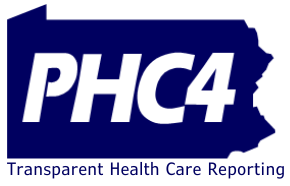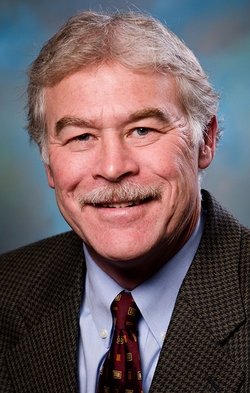When the Erie Community Foundation (ECF) perceived a lack of access to Primary Care Physicians (PCPs) existed in Erie County, it needed targeted data and analysis to prove it.
And the Pennsylvania Health Care Cost Containment Council (PHC4), through its Special Requests Unit, was there to assist.
According to Michael L. Batchelor, president of ECF, the foundation sought 2011 and 2012 inpatient discharge and ambulatory/outpatient procedure data based on patient records from specific zip codes in Erie County. The data was used to study primary care capacity and demand to guide future primary care access and quality initiatives.
“ECF was a big part of centralizing some of this activity but a broad group of employers, health plans, health care providers and non-profit organizations all saw the same need and worked cooperatively, as the Erie Healthcare Collaboration (EHC), to find a solution,” said Batchelor.
“We fortunately had the interest of General Electric, the largest private employer in Erie, which drove a lot of the effort. GE’s participation brought in the health plans, the health care providers and other parts of the community.”
In September 2013, EHC commissioned John Snow Inc. (JSI), an internationally recognized public health and health care consulting firm to assess Erie County’s long-term health care needs.
To complete its study, JSI collected and analyzed data from:
- county, federal and state sources, including PHC4
- a health care provider survey
- interviews with health care providers, social service agencies, academic institutions, business leaders and other partners
On the surface, statistics suggest Erie County has more physicians than the population requires, based on state and national comparisons. That broad analysis, which is typically conducted for a county or a region of the state, however, only tells part of the story, Batchelor says.
“The key was to dig deeper and analyze population and availability of medical services in targeted zip codes—analysis made possible through data provided by PHC4,” Batchelor explained. “PHC4’s data allowed JSI to conduct the study by zip code. PHC4 collects, scrubs and validates data, and no agency does it better.”
The JSI study showed zip code 16503 faced a significant number of challenges, including a large population of low-income residents. The inner city location, the area covered by 16503, has a population of 15,309 people and 9,937 of them are qualified as low-income. At the same time, 16503 had a disproportionate number of non-emergency visits to hospital emergency rooms because there is very limited access to primary care physicians, a situation that drives up the cost of health care.
“There were no primary care physicians in that zip code. There were some physicians on the very fringes of adjoining zip codes, for instance, but most residents had no access to them,” Batchelor said.
Based on population, 16503 needs to have the capacity to provide about 12,200 primary care visits annually to properly serve the population. At the time of the study, facilities there could accommodate only about 2,800 visits.
The study documented a markedly low number of providers in the rural areas of Erie County, as well as pockets of shortage within the City of Erie. Other parts of the City of Erie face PCP shortages, but none on the same scale as 16503.
The key to providing more and better access to health care and reducing non-emergency ER visits was to access federal funding to help create a health clinic to better serve those areas where shortages were documented, Batchelor said.
And that is how Wayne Primary Care (WPC) was created at Wayne School, home to pre-kindergarten through eighth-grade students.
“The federal Affordable Care Act (ACA) made school-based health center funding available,” Batchelor said. “We hope to make WPC part of the Federally Qualified Health Center (FQHC) System and have been working toward that since WPC opened.”
Gaining FQHC status will result in a greater rate of reimbursement for services, Batchelor explained, which would help the center as it moves toward self-sufficiency.
“Part of the ACA recognized low-income populations need more than the availability of private physician offices to attain better health care. That is why the ACA invests in community health centers. It is a more sustainable model for dealing with problem areas,” Batchelor said. “Erie County has about 280,000 residents. There are 93,385 low-income people, 12,942 of whom are served by health centers. We have been looking at multiple ways of serving those additional 80,443 people.”
ECF hopes to see two additional health centers established to help low-income residents. One already has received federal funding. Eventually, this countywide effort seeks to find creative ways to provide accessible primary care services to both rural and inner-city residents of Erie County.
WPC is open 8:30 a.m. to 5 p.m. and staffed by one physician and one nurse practitioner. The goal is to expand the center’s hours of operation and add providers.
“The center has 2,000 patients through word of mouth alone. We have held off on advertising, pending receipt of the FQHC status. There are 9,937 low-income people in 16503 who need to be served, so we have a ways to go in terms of meeting needs. At this time, we are hoping within the next 90 days that it will have FQHC status,” Batchelor said.
UPMC Hamot operates WPC with Primary Health Network, an FQHC based in Mercer County.
“Before trying to grow the patient base, we want the centers to be FQHC qualified so that we can add additional providers and expand the hours beyond 8:30 to 5. We would be able to add evening hours and Saturday options. But the center has to be on a more sustainable economic path, and that will come with FQHC. It will mean a higher rate of federal reimbursement for health care services provided, and that will go toward sustainability and expansion,” Batchelor explained.
In-school health centers quickly become part of a community’s daily life, not only for students and staff but also for all those living in the school district.
“The idea is if you can get your kids to school, you can get a sick family member to the center and it is part of a familiar place where people are comfortable,” Batchelor said. “That means more people will seek health care sooner and the overall health of the community will improve.
“The health center has a food bank outlet and can send kids home with a backpack of food in emergency situations. The center does education programs—about good dental hygiene or bullying—in other areas of the school that can accommodate larger groups. The children are attending and are engaged; they are benefiting. I’ve been there and witnessed it.
“We are seeing some amazing things.”
Return to the Case Studies page: VIEW ALL CASE STUDIES


